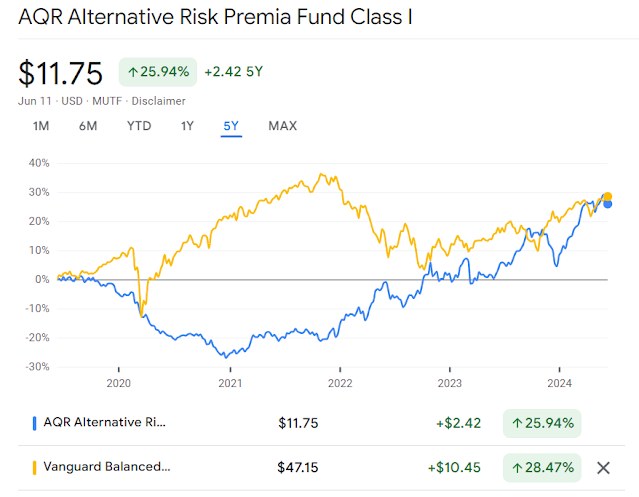Bloomberg had a longish writeup about quantitative investment strategies or QIS. The very basic idea seems to be that it is in the neighborhood of being strategy replication. From the article, QIS are usually structured products or swaps that target risk premia with the following list of different strategies provided in the article.
Risk premia is a fancy term often ascribed to alternative strategies. AQR has a fund called Alternative Risk Premia with symbol QRPIX. The text book definition is the difference between expected return on a security and the "risk-free rate of return" which is how T-bills are described.
QRPIX has an interesting chart. It was negatively correlated up through 2022 and while the correlation is still negative, for the last year, both it and VBAIX are up over the last year with QRPIX having doubled the return of VBAIX in that time. QRPIX' standard deviation is pretty high for an alt, just a little less than VBAIX.
The Simplify Multi-QIS Alternative ETF (QIS) is a newer fund that would appear to be in the same arena.
The chart tells you that QIS comes at it differently than QRPIX. Where QRPIX looks more like managed futures, which is one of the strategies used in QRPIX, QIS looks like it is trying to be a horizontal line that tilts upwards like merger arbitrage or convertible arbitrage. Simplify says the objective for QIS is absolute return with income so a result that looks similar to arbitrage makes sense to me.
Bloomberg says that the QIS products from the banks, so the structured notes and swaps as opposed to these two funds, "come with a handbook about exactly how they work." Later in the article there is more conversation about the transparency. The literature for QRPIX seems somewhat transparent other than there is a lag but there is good color. The page for QIS seems to be less transparent.
QRPIX uses a lot of leverage to build a long and short book with strategies that include "equity, global macro and managed futures." There is also an aspect of risk parity. As of March 31, the risk, not the holdings, was allocated with 15.6% to commodities, 14.7% to currencies, 17.8% to equity, 15.8% to fixed income and 36.1 to "stocks and industries" which I presume are narrower, more idiosyncratic bets in the equity market.
The QIS info pages say the fund allocates to 10-20 quantitative investment strategies in equities, interest rates, commodities, currencies and credit. It's an ETF so the positions are published, here is a partial screen grab.
Again, that is a partial list only. The fund primarily accesses QIS in the manner described in the Bloomberg article with total return swaps. There is a debit put spread on the S&P 500 which all by itself is a bearish position but I can't find anything to indicate what the current strategies are. So if there is better transparency for QIS, it's not that easy to find on the website.
Is there any reason to consider either of these funds or any others that might track one version of QIS or another? If there is a reason to buy QRPIX, I think it would be because an investor believed it to be a better mousetrap. It's managed futures-ish (with a couple of other things thrown in too) in terms of what it has done over the last six years.
The reason to consider QIS is a little different. Look at this backtest.
Again, it is insanely short because of how new QIS is. Client/personal holding PPFIX sells index puts that are very far out of the money as one type absolute return stream, floating rate debt is a different type of absolute return stream so it relies on different things than PPFIX and has different risks than PPFIX. Arbitrage, not in the back test, would be a third type of absolute return stream. QIS could potentially be a fourth type of absolute return stream. It would need to prove that it can actually deliver an absolute return stream and if I was going to consider QIS, I'd want to make sure it doesn't over lap with arbitrage strategies.
The word arbitrage is not in the prospectus so it potentially is a fourth kind of absolute return stream. The appeal then would be a new tool for diversifying your diversifiers. We can see in a year or two if it starts to prove itself out as I am describing which is based on the expectation I believe is being set by the fund but of course I could be wrong or the fund might not be able to execute as hoped for if my impression about the expectation is correct.
I'll just close out on the idea of giving something a year or two, or longer, to prove out. It is important to really play the long game with these sorts of things. For as much as I talk about managed futures and as happy as I was with the exposure during the financial crisis, I stayed away from the strategy for 8 or 9 years until buying Standpoint Multi-Asset (BLNDX) in early 2020.
The information, analysis and opinions expressed herein reflect our judgment and opinions as of the date of writing and are subject to change at any time without notice. They are not intended to constitute legal, tax, securities or investment advice or a recommended course of action in any given situation.








No comments:
Post a Comment